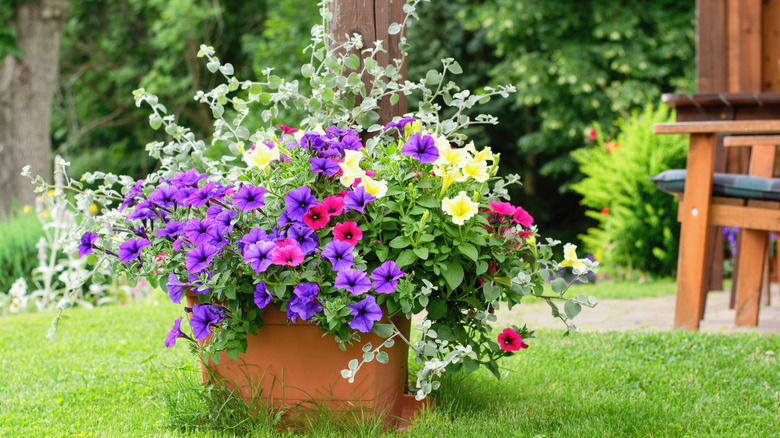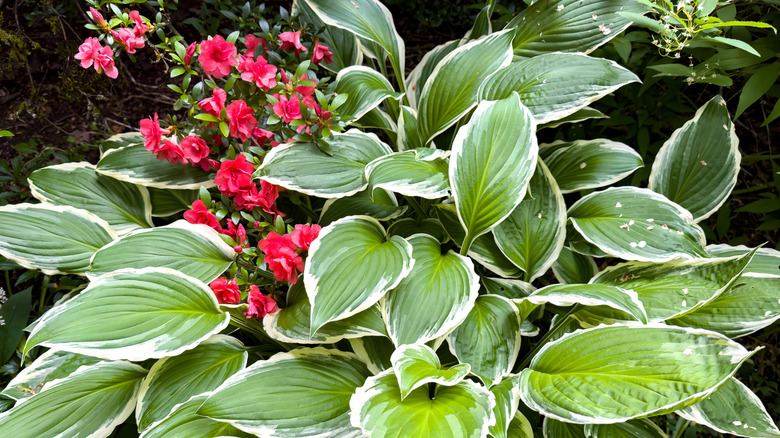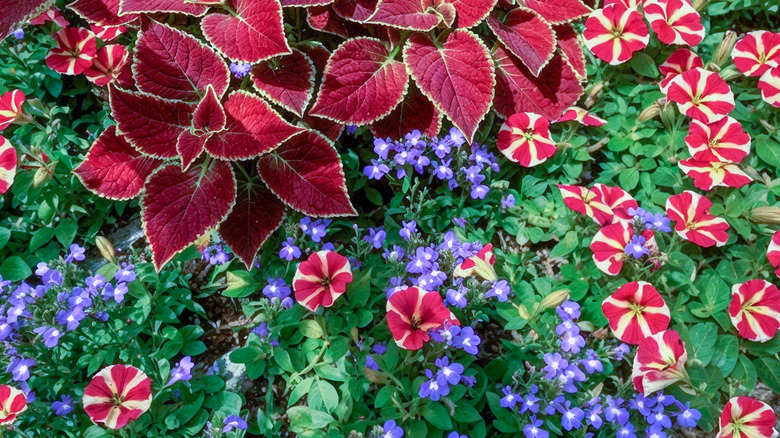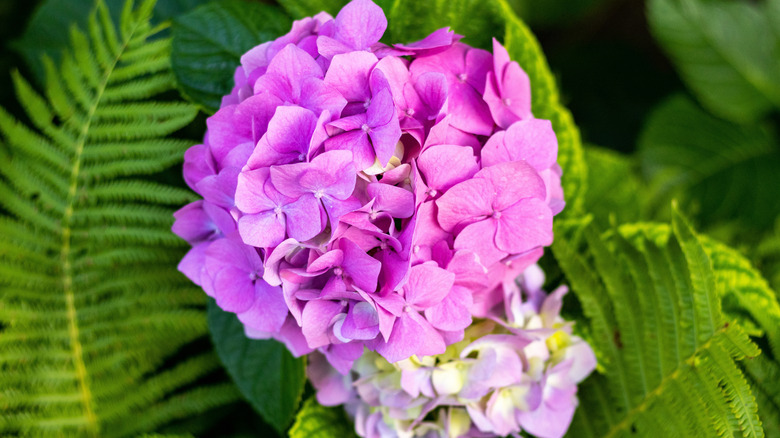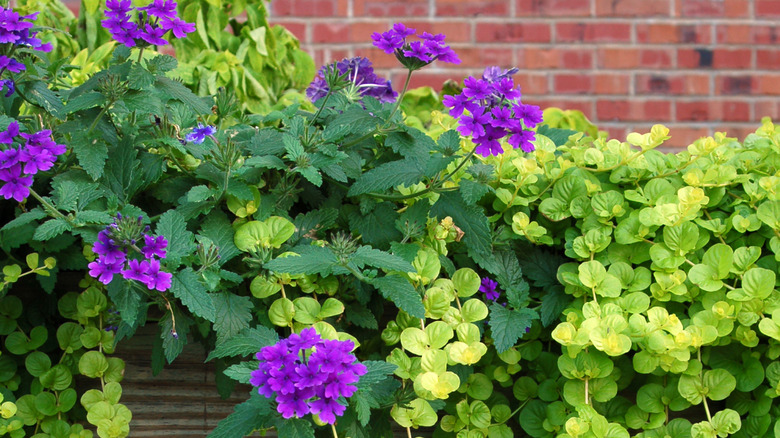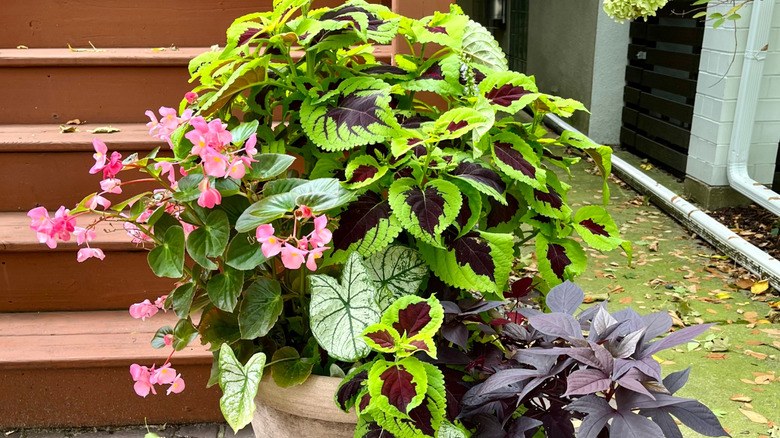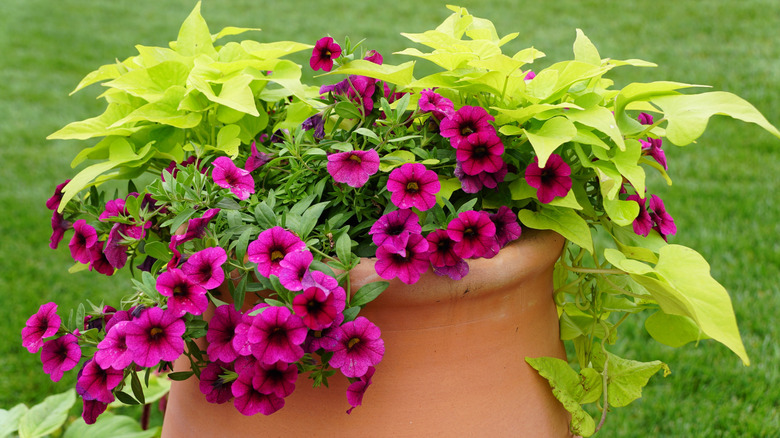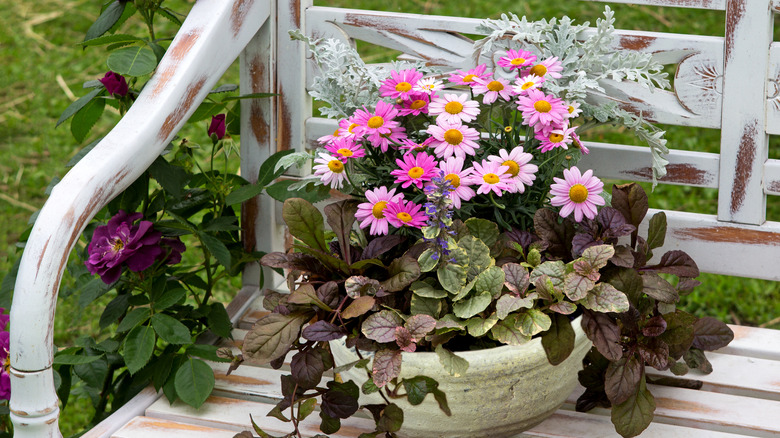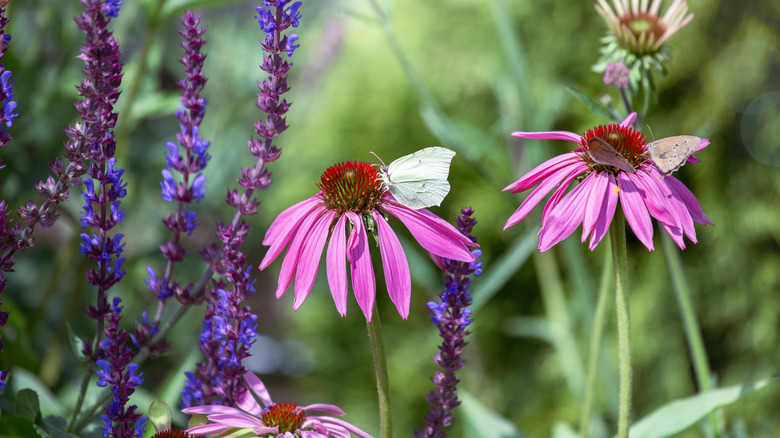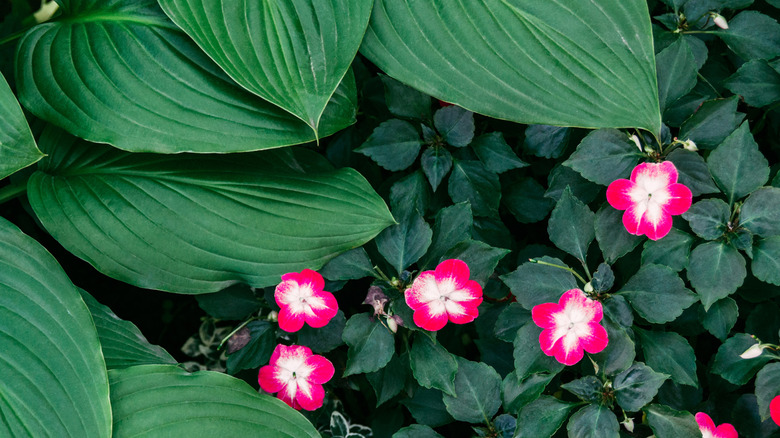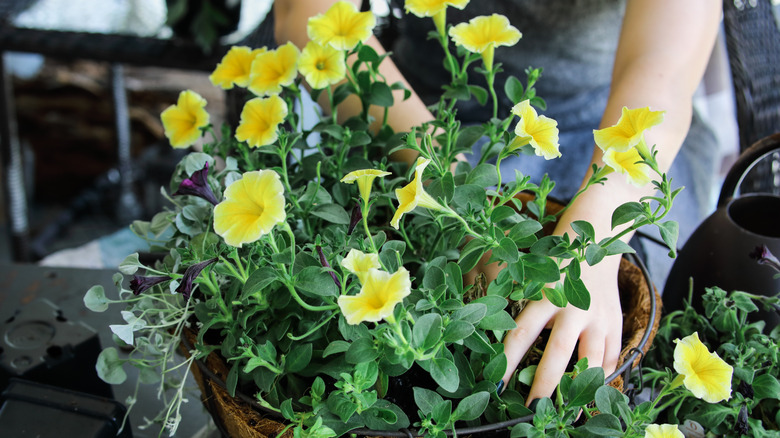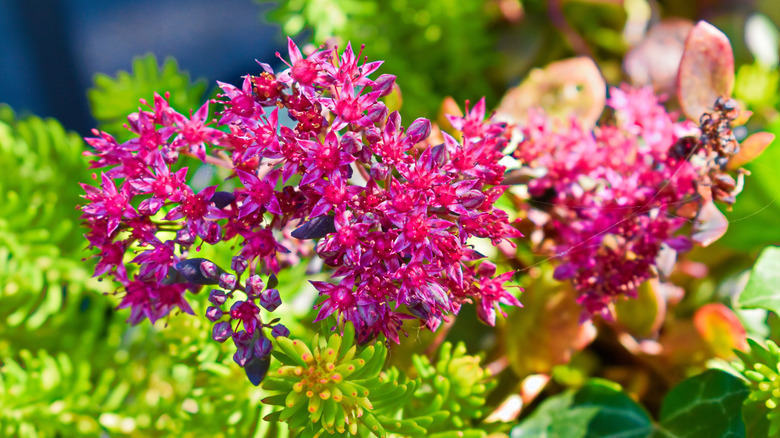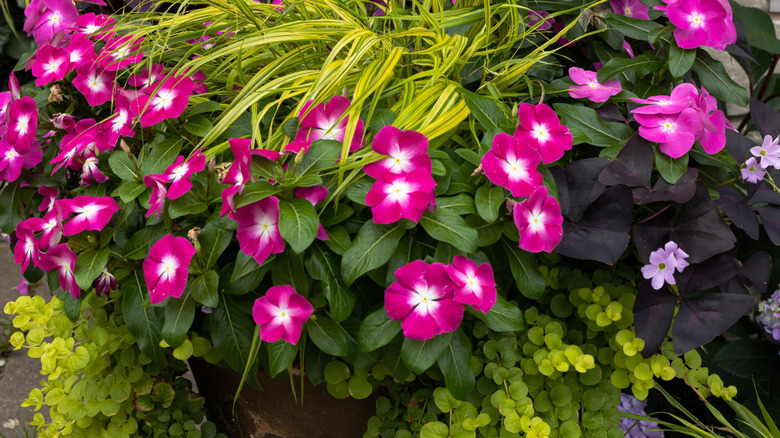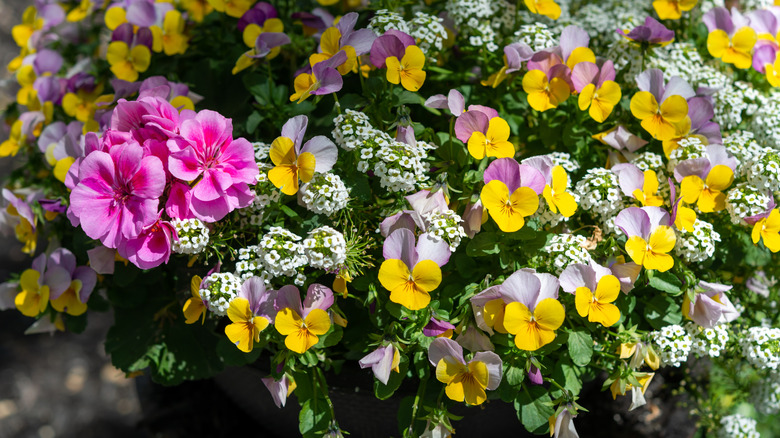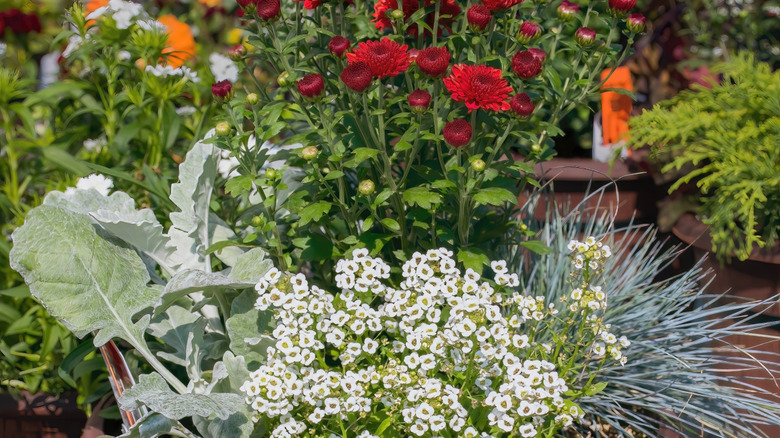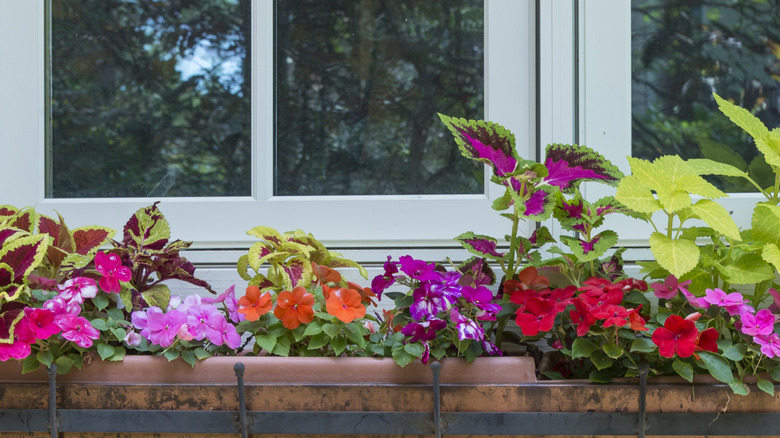15 Flower And Plant Combinations To Create A Dynamic Container Garden
Choosing flower and plant combinations for outdoor pots isn't just about picking the prettiest ones; all of the species should work together and create a blend of color, contrast, and texture for that truly dynamic look. One simple formula you should use when designing a container garden is the thriller, filler, spiller method. Your thriller plants add height to round out the display, fillers take up central space to prevent bare spaces, and spillers add more dimension while softening the edges as they trail over the side. That said, although the formula is a great starting point, there are dozens of ways to create eye-catching arrangements, even with just a couple of species. Ultimately, the best results come from mixing leaf shapes, sizes, colors, and flower forms to achieve added contrast and depth.
The only factor more important than creating an aesthetically pleasing design is choosing plants with similar care requirements. When keeping several plants in one container, you'll have to make sure they have matching sunlight, soil, and watering needs to thrive in the same space. Even the most beautiful combination won't last long if one plant loves full sun and dry soil while the other craves shade and constant moisture. By selecting compatible companions, you can create a cohesive look that will not only flourish but will be easier for you to maintain. If you're stuck on which plants and flowers to choose, the list below will give you some inspiration to help you get started.
Azaleas and hostas
If you want more texture in your containers, a hosta is the perfect shade-loving perennial to plant alongside your stunning azaleas. Coming in a variety of leaf sizes and color combinations, hostas provide a striking contrast against the azalea's warm flower colors. As a bonus, because azaleas are toxic to rabbits, planting them next to your hostas may deter unwanted leaf nibbling. Both plants thrive in similar conditions, preferring well-drained, acidic soil and dappled shade, making them an attractive yet highly compatible combination.
Striped petunias, lobelia, and coleus
When looking for the perfect trio for the thriller, filler, spiller method, you can't go wrong with striped petunias (Petunia × hybrida), lobelias (Lobelia erinus), and coleus (Coleus scutellarioides). Coleus adds height and drama with its bold, pigmented foliage, while the petunias fill the space with vibrant rounded blooms. Trailing lobelia ties the layered look together by gracefully spilling over the edge, and its delicate flowers add an extra burst of color. This combination does best when grown in partial sun, as a coleus plant may wilt in full sun. Plant in well-drained, slightly acidic soil.
Hydrangeas and ferns
Create an elegant container display by pairing a hydrangea's bright, clustered blooms with the fern's fine, lacy leaf texture. Because most hydrangea species can get quite large over time, opt for a dwarf variety, like Little Honey (Hydrangea quercifolia 'Little Honey'). As for ferns, the Japanese painted fern (Athyrium niponicum) stands out with its array of cultivars that come in striking shades of green, silver, red, and purple. Plant this attractive duo in rich, well-drained soil in a shady area, and water the soil thoroughly once it dries out to keep it consistently moist.
Clump verbena and creeping Jenny
Sometimes, creating a thriller, filler, and spiller combination only takes two plants, like clump verbena (Glandularia canadensis) and creeping Jenny (Lysimachia nummularia). Also known as rose vervain, clump verbena forms a dense, spreading mound with bright flower clusters held on ascending stems, providing fullness with a touch of height within one plant. Meanwhile, creeping Jenny's pale green, rounded leaves contrast beautifully against verbena's dark, deeply lobed foliage. Plant this pair in well-drained soil in an area that receives full sun.
Begonia, caladiums, coleus, and purple sweet potato vine
Combine begonias, caladiums, coleus, and purple sweet potato vine in a container for a dynamic blend of vibrant colors and interesting textures. Begonias are already popular with pollinators, but a study in the Journal of Economic Entomology suggests you can attract even more bees and butterflies with cultivars like "Cocktail Brandy" or "Ambassador Rose Blush." Caladiums and coleus come in a wide range of shades and textures to choose from, and purple sweet potato vine makes a stunning, easy-to-grow spiller. All thrive in rich, well-drained soil and partial shade.
Petunias and sweet potato vine
Caring for a mixed container filled with color and texture may seem like hard work, but this pair keeps things simple. Petunias and sweet potato vines (Ipomoea batatas) are low-maintenance beauties that thrive in well-drained soils and full sun to partial shade, and they're both drought-tolerant once established. For added height and dimension, consider including a compatible thriller like purple fountain grass (Pennisetum setaceum 'Rubrum'), though these two are charming enough on their own.
Marguerite daisies, dusty miller, and bugleweed
It may not seem like the cottage charm of Marguerite daisies (Argyranthemum foeniculaceum), the ethereal vibe of dusty miller (Centaurea cineraria), and bugleweed's (Ajuga reptans) moody foliage would work well together, but when combined, they create an unexpectedly stunning display. Dusty miller provides a crisp, white backdrop that lets the vibrant shades of marguerite daisies shine, and bugleweed's purple leaves and flower spikes give it an attractive textural and tonal contrast. Grow this group in a container with well-draining soil in a full sun location.
Coneflower, sage, and ornamental grass
Coneflower (Echinacea purpurea), sage (Salvia officinalis), and ornamental grass make the perfect trio to create vibrant shades with varying shapes and textures. This gorgeous combination is well-suited for beginner gardeners looking for low-maintenance flowers that look beautiful in container gardens. Bees and butterflies will love visiting the sage and coneflower, and the ornamental grass gives small insects a shady habitat. Each flowering plant thrives in full sun and well-draining soil, so make sure to choose an ornamental grass with similar needs.
Busy Lizzies and hostas
If you're looking for beautiful spring annuals to turn your garden into a colorful showstopper, consider adding the prolific-blooming busy Lizzies (Impatiens walleriana) to your outdoor containers. Hosta's bold, textured leaves will delightfully stand out against the soft pink, purple, or white multi-seasonal blooms. To make your container even more visually interesting, pair bicolor busy Lizzies with a variegated hosta variety. Both of these stunners are shade-tolerant, making them perfect for areas of your yard that don't see a lot of sun. Each plant happily grows in rich, slightly acidic, well-drained soil.
Petunias and silver nickel vine
For a low maintenance but charming pairing, combine petunias (Petunia × hybrida) with silver nickel vine (Dichondra argentea 'Silver Falls'). Petunias are among the most popular garden plants, known for their tubular-shaped, colorful blooms that are sure to attract more hummingbirds to your yard. These pretty flowers work wonderfully to fill out containers, while silver nickel vine's moonlit, rounded leaves gently pour over the pot. Consider adding a thriller plant that thrives alongside petunias, like summer snapdragon (Angelonia angustifolia), to add more vertical dimension. Plant them in well-drained soil in full sun or dappled sunlight.
Sedum 'Dazzleberry' and sedum 'Angelina'
You can have a lot of fun pairing stonecrop (Sedum) together in a container garden, but 'Dazzleberry' and 'Angelina' are two cultivars you won't want to skip. Aptly named, 'Dazzleberry' features bright, raspberry-toned blooms that are like magnets to butterflies, paired with fleshy, bluish-gray foliage that holds its color throughout the year. 'Angelina' is another succulent-like sedum with brilliant yellow to gray-green, needle-like leaves that develop striking red or coppery tones in the fall. Sedum thrives on neglect, asking only for a container with well-drained, neutral to alkaline soil placed in a sunny spot.
Rose periwinkle, creeping Jenny, and purple shamrock
If you want to create a stunning trio, rose periwinkle (Catharanthus roseus), creeping Jenny, and purple shamrock (Oxalis triangularis) are sure to make a statement in your container garden. Rose periwinkle puts out pink, purple, white, or yellow blooms from summer through frost, while purple shamrock's delicate pale pink or purple flowers appear in summer and fall (though the rich, triangular foliage is the real star of the show). Creeping Jenny's vibrant chartreuse foliage will drape elegantly over the side to tie the look together. Plant them in well-drained soil in full sun.
Pansies, geraniums, and sweet alyssum
For a cheerful cottage vibe, give pansies (Viola × wittrockiana), geraniums (Pelargonium), and sweet alyssum (Lobularia maritima) a try. This pretty trio combines bold shades with soft textures that offer an eye-catching yet cozy flower arrangement. Geraniums add height and color with upright blooms in vibrant hues, while pansies help to fill out the middle with their compact growth and delicate flowers. Sweet alyssum's tiny flower clusters fill in the gaps and give the container added texture without being overwhelming. Invite pollinators to your garden by planting these three in well-drained soil with full sun to partial shade.
Mums, dusty Miller, blue fescue, and sweet alyssum
For a gorgeous fall combo, arrange mums (Chrysanthemum), dusty miller (Senecio cineraria), blue fescue (Festuca glauca), and sweet alyssum in an outdoor container. Mums offer blooms in seasonal shades like red, orange, and yellow, while dusty miller and blue fescue add additional color and more contrast to the display. Sweet alyssum completes the look with its delicate layer of blooms surrounding the base. This low-maintenance group grows best in full sun and well-drained soil.
Impatiens and coleus
To grow a flourishing shade garden, the tried-and-true combination of impatiens and coleus is a foolproof pairing for darker areas. While you're only working with two different species, both impatiens and coleus come in an array of cultivars, styles, and colors to create the exact aesthetic you're looking for. The compact growth habit of impatiens pairs beautifully with coleus's mounding form, giving your pot plenty of texture and contrast between the two of them. Plant them in well-drained soil and give them a shady spot to grow.
